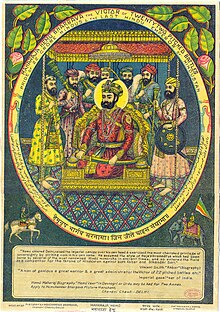History of Haryana
This article needs additional citations for verification. (April 2012) |
Haryana is a state in India. During the British Raj period it was administered as a part of the Punjab province. It became a separate administrative entity in 1966.
Vedic period
In some ancient Hindu texts, the boundaries of Kurukshetra correspond roughly to the state of Haryana. Thus according to the Taittiriya Aranyaka 5.1.1., the Kurukshetra region is south of Turghna (Srughna/Sugh in Sirhind, Punjab), north of Khandava (Delhi and Mewat region), east of Maru (desert) and west of Parin.[1]
Medieval period

After ousting the Huns, king Harshavardhana established his capital at Thanesar near Kurukshetra in the 7th century AD. After his death, the kingdom of his clansmen, the Pratiharas ruled over a vast region for quite a while from Harsha's adopted capital Kannauj. The region remained strategically important for the rulers of North India even though Thanesar was no more as central as Kannauj. Prithviraj Chauhan established forts at Taraori and Hansi in the 12th century. Muhammad Ghori conquered this area in the Second Battle of Tarain. Following his death, the Delhi Sultanate was established that ruled much of India for several centuries. The earliest reference to 'Hariana' occurs in a Sanskrit inscription dated 1328 AD kept in Delhi Museum, which refers to this region as The heaven on earth, indicating that it was fertile and relatively peaceful at that time. Firoz Shah Tughlaq established a fort at Hisar in 1354 to further fortify the region, and also constructed canals or rajwahas as they were referred to in the Indo-Persian historical texts.
The three famous battles of Panipat took place near the modern town of Panipat. The first battle took place in 1526, where Babur, the ruler of Kabul defeated Ibrahim Lodi of the Delhi Sultanate, through the use of field artillery. This battle marked the beginning of the Mughal empire in India. In the Second Battle of Panipat (November 5, 1556), Akbar's general Bairam Khan defeated the local Haryanvi, who belonged to Rewari, the last Hindu emperor of India, Samrat Hem Chandra Vikramaditya also called Hemu. Hemu rose from a businessman to become advisor to Afghan kings and then Prime Minister-cum-Chief of Army. He fought and won 22 battles in between 1553 to 1556, from Punjab to Bengal against Afghans and Mughals and won all of them without losing any. Hemu defeated Akbar's army at Tughlaqabad in Delhi and became emperor of North India at Delhi on 7 October 1556 declaring him self as a Vikramaditya king following the reigns of earlier Vedic kings.[citation needed] and paved the way for Akbar's reign. The Third Battle of Panipat was fought in 1761 between the Afghan warlord Ahmad Shah Abdali and the Marathas under Sadashivrao Bhau of Pune. Ahmad Shah won decisively, on January 13, 1761.
Formation of Haryana
On 1 November 1966, Haryana was carved out on the basis of that the parts of Punjab which were to be Haryana's "Hindi-speaking areas."Same example was followed in creation of Himachal Pradesh as well. Haryana state was formed on the recommendation of the Sardar Hukam Singh Parliamentary Committee. The formation of this committee was announced in the Parliament on 23 September 1965.
On 23 April 1966, acting on the recommendation of the Hukam Singh Committee, the Indian government set up the Shah Commission under the chairmanship of Justice J. C. Shah, to divide and set up the boundaries of Punjab and Haryana.
The commission gave its report on 31 May 1966. According to this report the then districts of Hissar, Mahendragarh, Gurgaon, Rohtak, and Karnal were to be a part of the new state of Haryana. Further the Tehsils of Jind (district Sangrur), Narwana (district Sangrur) Naraingarh, Ambala and Jagadhari of district Ambala were also included. The commission recommended that Tehsil Kharar (including Chandigarh) should also be a part of Haryana.[2]
